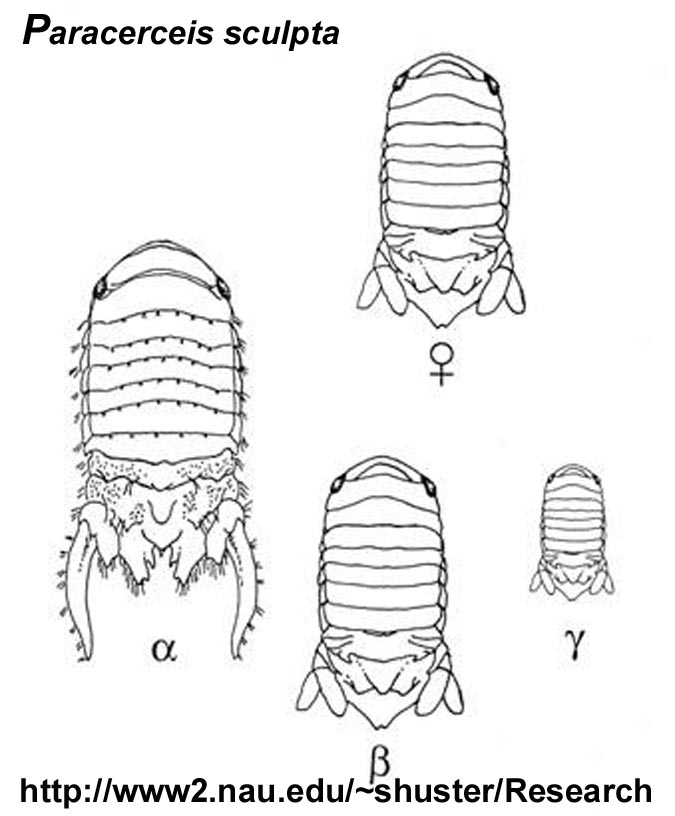 Before I got sidetracked into mating behaviour in slugs & snails, I was mulling over the idea of writing about something equally complex – the area of male polymorphisms & mating systems. So here we go.
Before I got sidetracked into mating behaviour in slugs & snails, I was mulling over the idea of writing about something equally complex – the area of male polymorphisms & mating systems. So here we go.
As the name suggests, a ‘male polymorphism’ is the condition where you get more than one ‘type’ of male in a species. Typically there are big, hefty, in-your-face males, but then there are also the smaller, retiring type, who don’t have the usual male appearance. And the polymorphism is stable, ie it persists from one generation to the next. How might this strange set-up have evolved?
Paracerceis sculpta is a small marine crustacean – the large males grow to about 8mm long. Females all look the same, no problems there. But the males! About 81% of the males are large, with long uropods (appendages found at the tail-end of the animal, & often used to transfer sperm). These are the a-, or alpha, males. But there are also b-males (‘beta’ males) & g-males (gamma males). Around 4% of the males are betas: smaller than the alphas, and similar to females in both appearance and behaviour. And the remaining 155 of males are gammas, which are very small and resemble juvenile animals (Shuster, 1987).
Figure showing the external differences between an alpha-male and a female P.sculpta.
P. sculpta lives on & in sponges. Sponges (interesting animals in their own right!) contain an internal space called a spongocoel – water flows into it through the small pores in the sponge’s sides & out through a larger opening, called an osculum, at the top. Anyway, the large alpha males of P. sculpta stake out the spongocoels & attract a harem of females, who live in the haemocoel & mate with the a-males. And the alpha-males vigourously defend their sponges, & their harems, from other alphas. So far, so straightforward, & a good example of polygyny.
But now things get more interesting. The smaller beta males, the ones that look like females? Well, the resemblance is strong enough that they can infiltrate the harem without raising the suspicions of the resident alpha. And then, while he’s defending his harem against other alphas, the stay-at-home beta male gets to sneak a few copulations of his own. Meanwhile the tiny gamma males also get to steal a few matings of their own, rushing in & out of the spongocoel without attracting the alpha’s attention.
The three male morphs of Paracerceis sculpta (from Stephen Shuster’s webpage).

What we seem to be seeing here is an Evolutionarily Stable Strategy: because all three morphs persist in the population, despite what would appear to be an imbalance of power & gene transmission that favours the dominant alpha morph, there must be some subtle benefits accruing to the beta & gamma males. What’s most likely is that the strong intrasexual competition between the alphas means that by no means all of the alpha males get to mate. And while those that do probably get the majority of matings, it’s quite possible that the time & effort they put into obtaining & defending a harem shortens their lifespan. The betas and gammas may have a lower rate of mating success, but if they live longer, this would balance out in the end, in terms of passing their chances of passing their genes on to the next generation.
An example where size really doesn’t matter…


Number8Dave says:
Very nice. A more familiar example of the same thing is found in red deer, where a few males (known as hummels) don’t grow antlers and generally avoid the intense competition between the alpha males, sneaking access to the females as and when they can.
Alison Campbell says:
I forebore to mention it at the time but some evolutionary biologists have even given this phenomenon a particular name. A rather naughty one. It can be attributed to the great John Maynard Smith, I think: ‘sneaky starts-with-f-&-rhymes-with-truckers’. (This is supposed to be a family-friendly blog, after all!)